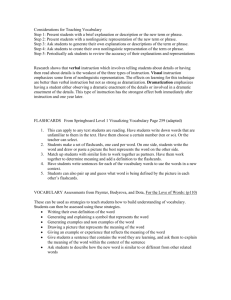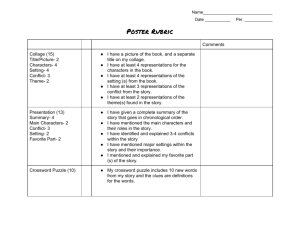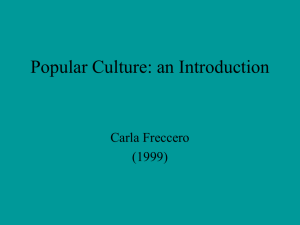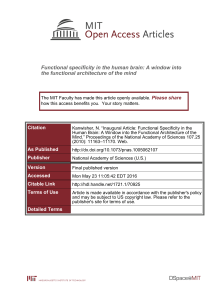Specific Types of Knowledge: Vocabulary and Details
advertisement
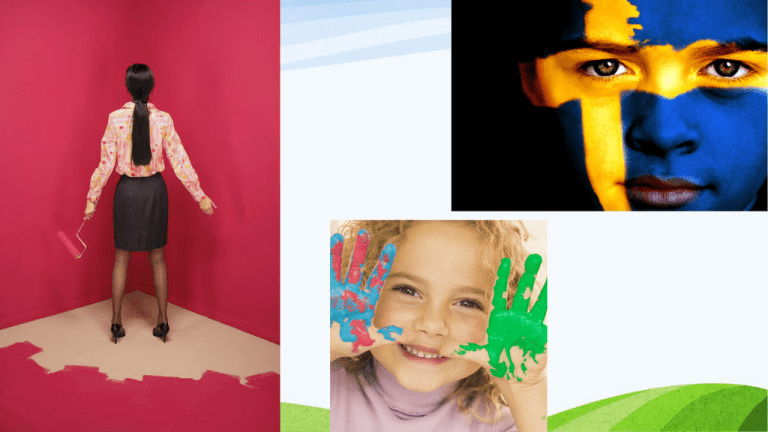
Specific Types of Knowledge: Vocabulary and Details Part I of 2 Page 291 Marzano considers strategies for four specific types of knowledge 1. Vocabulary terms and phrases 2. Details 3. Organizing Ideas 4. Skills and Processes The Research 22 Point Percentile Gain in Student Achievement “Vocabulary terms are a part of the K-12 classroom. Research shows that direct vocabulary instruction improves students’ achievement. When students have instruction on new words, they are more likely to understand the words in context when they encounter them again.” “Students must encounter words in context more than once to learn them.” “…words are critical to learning the new content. Associating an image with a vocabulary term is one of the best ways to learn a new word.” Essential Questions • How much do you recall about the photographs? • What colors were in the lady’s shirt? • What color was the young man’s eyes? • What color of paint were on the girl’s right hand? It was on the board? Didn’t you just hear me say… We fail to make connections with the students and then ask them to recall so many unrelated inexplicit details. What if? • When you walked in I said that I wanted you to take note of all of the details that you see in the photographs above. In a moment I am going to take them away and have you to recall as many as you can without looking at the photograph. • How many of you would recall more information? Why? • We will do more activities with these words throughout to week so that you can understand these words in reading, writing, and listening. Recommendations for Classroom Practice • Using a five-step process • Asking questions for teaching vocabulary to help students generate information about different types of terms Using a Five Step Process for Teaching Vocabulary • Multiple exposures 1. Present students with a brief explanation or description of the new term or phrase. 2. Present students with a nonlinguistic representation of the new term or phrase. 3. Ask students to generate their own explanations or descriptions of the term or phrase. 4. Ask students to create their own nonlinguistic representations of the term or phrase. 5. Periodically ask students to review the accuracy of their explanation and representations. 5 step process in practice 1. Assemble groups of 10 or less 2. Match the teacher’s action to the step that is most likely describes Ask Questions to Help Students Generate Information About Different Types of Terms • Vocabulary Notebook – a place to record explanations and nonlinguistic representations. (sample questions to draw out explanations pg. 298 fig. 23.5) Reflection: Describe where you are in this strategy? Most of us give nonlinguistic representations…how many allow students to create, analyze, interpret and assess their own representations? CCSS – Instructional Strategies/Thick and Thin Questions pg. 18 Language K-5 HCSD guide Assessing the Impact • Student pg. 300 • Teacher pg. 303 Details Pg. 305 Details “Details are very specific pieces of information” 1. Facts – person, place, living/nonliving thing, event 2. Time Sequences – between two points of time – first, second etc. 3. Cause and effect sequences/causal – ex: The events leading to the Russian Civil war. 4. Episodes – setting, specific participants, particular duration, specific sequence of events, particular cause-and-effect Recommendations for Classroom Practice • Expose students to key details multiple times • Using dramatic representations of key details Expose students to Key Details Multiple Times (at least three) ex. The Whiskey Rebellion Time Sequence Organizer (pg. 308/ fig 24.2) Next few days…Video, Summary (homework) Class discussions – episode guidelines Use Dramatic Representations of Key Details “Research indicates that DRAMATIC REPRESENTATION has the biggest effect on student’s learning.” ex: act out the process of oxygen, cellular towers, scene from a story, mathematical formulas Assessing the Impact • Students pg.310 fig. 24.4 • Teacher pg. 311-312 fig. 24.5 Peer Share Marzano Nine Instructional Strategies Teacher Toolbox • Cooperative learning • Setting objectives and providing feedback • Homework and practice • Reinforcing effort and providing recognition • Specific types of knowledge *Multiple Exposures – Dramatic – Nonlinguistic Connected Nsider KNews – Be N the KNow • Update your skills/rosters in Conflux – Heather Homan/Michelle Ray • Visible Objectives with CCSS reference numbers • K-5 – Teaching Common Core • Elective teachers working toward integration on CCSS • Mentor Reports Friday @ 10:00 a.m. • 100% Independent study rewards • Complete the State survey at your earliest convenience.



